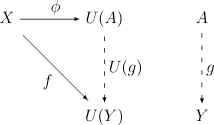
In various branches of mathematics, a useful construction is often viewed as the “most efficient solution” to a certain problem. The definition of a universal property uses the language of category theory to make this notion precise and to study it abstractly.
This article gives a general treatment of universal properties. To understand the concept, it is useful to study several examples first, of which there are many: all free objects, direct product and direct sum, free group, free lattice, Grothendieck group, Dedekind-MacNeille completion, product topology, Stone–Čech compactification, tensor...